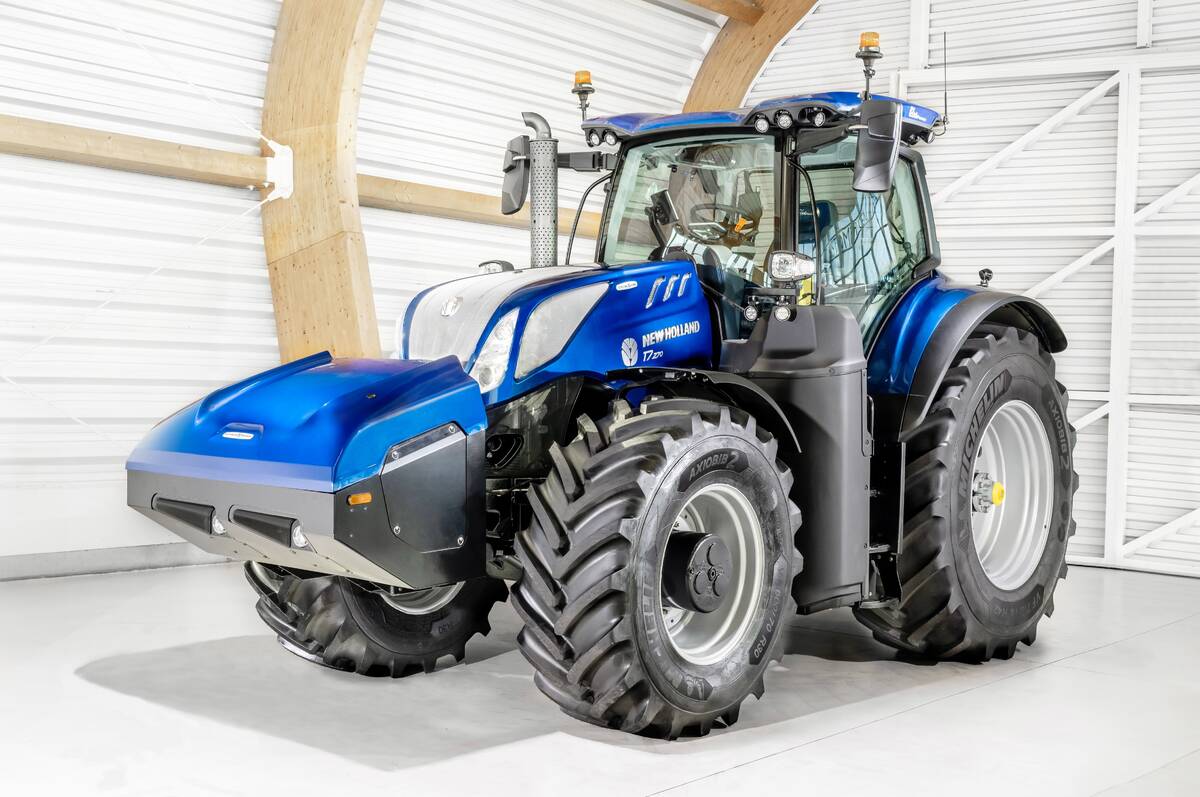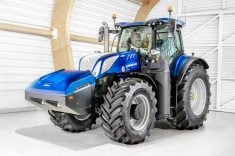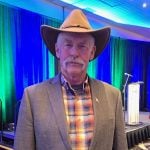Agriculture can be a tough game so there’s a special spot for the few select machinery makers that last beyond a century.
For New Holland, the century mark was passed some time ago as the company this year reaches 125.
Saskatoon remains one of New Holland’s important hubs where it develops the latest in seeding technology, air seeding and commercial-scale planters.
In Fargo, North Dakota, the company produces its articulated tractors, including the regional favourite, the T-9 series. Straight south, at Grand Island, Nebraska, is the development home of another line popular on the Canadian Prairies and United States Great Plains: the twin-rotor combines. And not too far away at Racine, Wisconsin, the T-8 tractor line is constructed. Of course, the namesake hay and forage equipment is built nearer the eastern seaboard, at New Holland, Pennsylvania.
Read Also

Methane tractor debuts at Agritechnica 2025
New Holland has unveiled its production-ready version of a T7.270 methane-powered tractor at the Agritechnica farm machinery show in Hanover, Germany.
In 1895, blacksmith and inventor Abe Zimmerman opened a shop in New Holland, Pennsylvania.
Starting with stationary engines and a feed grinder for products, Zimmerman expanded the line based on regional farmers’ demands for greater mechanization and farming capacity, which at that time included wood saws for managing and clearing land. At the end of the 1930s, the company launched the world’s first self-tying, automatic pickup baler.
After the Second World War, it was sold to the Sperry Corp., which saw expansion into forage equipment and developed the concept of producers being able to “make hay in a day” with the first haybine, which cut and conditioned in a single unit. It also developed the twin rotor combines in the 1970s.
Sperry-New Holland purchased the Belgan self-propelled combine maker Claeys in 1964 and used that knowledge to enter the combine market globally.
Sold to Ford in 1986, New Holland merged its interest in farm machinery dating back to first mass-produced tractor, the Fordson Model F, in 1917.
Its Canadian heritage was created with Ford’s acquisition of Winnipeg’s Versatile tractor company in 1987 and its incorporation into the New Holland lineup in a move that nearly created a full-line farm machinery company.
In 1991, Fiat purchased Ford’s interest. With its European tractor history dating back to the end of the First World War and its existing farm machinery range, the company became an international heavyweight.
In 1993, it began offering the mechanical front-wheel drive Genesis tractors and five years later picked up Flexi-Coil in Saskatoon.
In 1999, it became part of a merged company with Case IH, leading to the formation of CNH.
New Holland has continued to acquire lines of equipment, including the Miller sprayers in 2014 and European farm equipment builder Kongskilde with its advanced haying tools.
The company has been a leader in autonomous and clean fuel tractor concepts and designs.
Carlo Lambro, New Holland’s president said the company has remained competitive through developing new tools that producers demand and providing support for their investments.
“We are living in extraordinary circumstances that are changing how we live and work in ways we could never have imagined.”
“This situation has highlighted the vital role of agriculture and brought to the attention of the public how important farmers are in their life. Agriculture has reacted to the crisis with strength, successfully ensuring the food supply without disruption in the face of exceptional difficulties.
“And New Holland has remained at the farmers’ side throughout, providing the support they needed. We continue to invest in the future, and we will make the most of the possibilities of new technologies, connectivity, automation and alternative fuels – working together towards sustainable agriculture,” he said.















